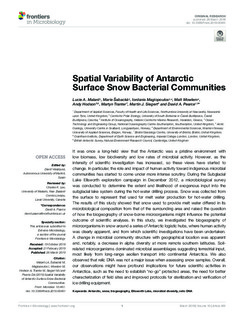| dc.contributor.author | Malard, Lucie A. | |
| dc.contributor.author | Sabacka, Marie | |
| dc.contributor.author | Magiopoulos, Iordanis | |
| dc.contributor.author | Mowlem, Matt C. | |
| dc.contributor.author | Hodson, Andrew J. | |
| dc.contributor.author | Tranter, Martyn | |
| dc.contributor.author | Siegert, Martin J. | |
| dc.contributor.author | Pearce, David A. | |
| dc.coverage.spatial | Antarctica | nb_NO |
| dc.date.accessioned | 2019-06-11T11:49:52Z | |
| dc.date.available | 2019-06-11T11:49:52Z | |
| dc.date.created | 2019-04-01T10:29:56Z | |
| dc.date.issued | 2019 | |
| dc.identifier.citation | Malard, L. A., Šabacká, M., Magiopoulos, I., Mowlem, M., Hodson, A., Tranter, M., . . . Pearce, D. A. (2019). Spatial variability of antarctic surface snow bacterial communities. Frontiers in Microbiology, 10. | nb_NO |
| dc.identifier.issn | 1664-302X | |
| dc.identifier.uri | http://hdl.handle.net/11250/2600490 | |
| dc.description.abstract | It was once a long-held view that the Antarctic was a pristine environment with low biomass, low biodiversity and low rates of microbial activity. However, as the intensity of scientific investigation has increased, so these views have started to change. In particular, the role and impact of human activity toward indigenous microbial communities has started to come under more intense scrutiny. During the Subglacial Lake Ellsworth exploration campaign in December 2012, a microbiological survey was conducted to determine the extent and likelihood of exogenous input into the subglacial lake system during the hot-water drilling process. Snow was collected from the surface to represent that used for melt water production for hot-water drilling. The results of this study showed that snow used to provide melt water differed in its microbiological composition from that of the surrounding area and raised the question of how the biogeography of snow-borne microorganisms might influence the potential outcome of scientific analyses. In this study, we investigated the biogeography of microorganisms in snow around a series of Antarctic logistic hubs, where human activity was clearly apparent, and from which scientific investigations have been undertaken. A change in microbial community structure with geographical location was apparent and, notably, a decrease in alpha diversity at more remote southern latitudes. Soil-related microorganisms dominated microbial assemblages suggesting terrestrial input, most likely from long-range aeolian transport into continental Antarctica. We also observed that relic DNA was not a major issue when assessing snow samples. Overall, our observations might have profound implications for future scientific activities in Antarctica, such as the need to establish “no-go” protected areas, the need for better characterization of field sites and improved protocols for sterilization and verification of ice drilling equipment. | nb_NO |
| dc.language.iso | eng | nb_NO |
| dc.publisher | Frontiers Media S.A. | nb_NO |
| dc.rights | Navngivelse 4.0 Internasjonal | * |
| dc.rights.uri | http://creativecommons.org/licenses/by/4.0/deed.no | * |
| dc.title | Spatial Variability of Antarctic Surface Snow Bacterial Communities | nb_NO |
| dc.type | Journal article | nb_NO |
| dc.type | Peer reviewed | nb_NO |
| dc.description.version | publishedVersion | nb_NO |
| dc.rights.holder | Copyright © 2019 Malard, Šabacká, Magiopoulos, Mowlem, Hodson, Tranter, Siegert and Pearce | nb_NO |
| dc.subject.nsi | VDP::Matematikk og Naturvitenskap: 400::Basale biofag: 470::Generell mikrobiologi: 472 | nb_NO |
| dc.source.pagenumber | 12 | nb_NO |
| dc.source.volume | 10 | nb_NO |
| dc.source.journal | Frontiers in Microbiology | nb_NO |
| dc.source.issue | Art. 461 | nb_NO |
| dc.identifier.doi | 10.3389/fmicb.2019.00461 | |
| dc.identifier.cristin | 1689352 | |
| cristin.unitcode | 203,12,0,0 | |
| cristin.unitname | Fakultet for ingeniør- og naturvitskap | |
| cristin.ispublished | true | |
| cristin.fulltext | original | |
| cristin.qualitycode | 1 | |

